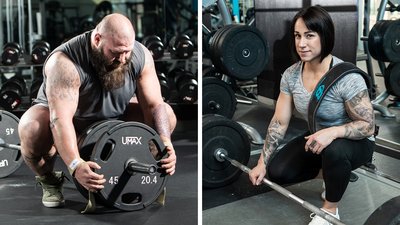Powerlifting for Beginners | Nutrition for Powerlifters | Powerlifting vs. Bodybuilding | Powerlifting Training for Women | Powerlifting Meet Prep | Advanced Powerlifter Pro Tips | Essential Powerlifting Gear
Powerlifters live to squat, bench, and deadlift. But even if you specialize in the competition movements, they can't be all you do in the gym. Variations of the big three and smart accessory work are essential for lifting big numbers, preventing injury, and building the special type of functional strength known in elite powerlifting as "general physical preparedness."
Both Robb Philippus and Laura Phelps hold world records in powerlifting and have years of experience under their lifting belts. They agree that varying your exercises and adding accessory work are non-negotiables if you want to improve.
Here's what these world-class lifters use to build their big lifts.
Why do I need accessory moves?
"The biggest thing is that they give you a fresh look at submaximal weights that increase the time under tension and reveal weak points," Philippus says.
Phelps, who was the first woman to squat 700 pounds and held numerous records while training with Westside Barbell, takes it a step further. She explained on the Bodybuilding.com Podcast that she devotes a majority of her portion to accessory movements, and credits them for an injury-free 10-year career.
"Emphasizing what we call 'special exercises' can help correct movement patterns or strengthen points of weakness that the larger compound lifts can expose, but not necessarily fix," Phelps explains. "It's also a great way to train when you have a tweak that you're trying to work around and be able to maintain your strength for the main lifts while rehabbing it."
Here are their most powerful extras for supporting the big three:
The Best Squat Accessory Moves
Laura Phelps: "GHRs are an incredible isolated hamstring developer that still recruits from your glutes and calves, as well. The angle also has more of a transfer to the squat than a standard leg curl and makes it more challenging than other hamstring exercises. You're using body weight, so you don't have a machine helping or guiding you either."
2. Lunge Variations
Laura Phelps: "We do a ton of different variations—standard barbell back lunges, or with an SSB or regular barbell with chains, front rack, Bulgarian split squats. Any of these are awesome because they're a total leg developer: hams, glutes, quads, core, everything. You really can't go wrong with any of them."
3. Back Squat with a Pause
Robb Philippus: "The paused squat allows the lifter to become comfortable being in the hole of the squat, where many novices or beginners need the most technique help. It also increases time under tension, and you'll learn where your weaknesses are, whether it's mobility or strength out of the bottom. It can help fix bar position, head position, and bracing ability, too."
Make your squat stronger and safer with a high-quality lifting belt. If you're getting serious about the powerlifts, it's a must.
4. Safety Squat with Hand Support (Hatfield squat)
Robb Philippus: "With this you can overload the bar without changing the motor pattern of the hips. It teaches the lifter to sit back into the squat, too. Most people get very uncomfortable doing that; they feel that transition into the heels and get gun-shy actually committing to the lift. When you overload with up to 20 percent over a max weight, it can really help a lifter learn how to not question the movement."
The Best Bench Press Accessory Moves
1. Pin Press
Robb Philippus: "The pin press or 'dead press' is going to target right where the sticky point is in the range of motion and focus on the lockout. Working up to a 1RM within 80 percent of your full competition bench would be the goal."
2. Spoto Press
Robb Philippus: "This is a bench press, but you pause with the bar slightly above the chest. It's going to show you where your form breaks down. It's very hard to stay tight for the amount of time it takes to do this lift. You aren't totally limiting the stretch reflex, but you're going to reduce it quite a bit. This will help with overall tightness and learning to fail in position."

3. Floor Press (barbell or dumbbells)
Laura Phelps: "You should come to a complete pause with your elbows on the floor. The idea is letting the weight 'die' on the floor—that's what teaches you how to keep your back tight and recruit those upper-back muscles to press the weight. People don't really know how to press off their chest with their lats or upper back and end up driving with their shoulders. This is a really good corrective exercise for that."
Laura Phelps: "I like these because they work the lower part of your triceps just above your elbow. Those are the muscles that really flex your elbow and lock weights down. If you've never done them before, it might feel odd, like it's bothering your elbows, but that's usually because that part of your triceps has never been worked."
The Best Deadlift Accessory Moves
1. Good Morning
Laura Phelps: "This movement mimics your deadlifts basically without the arms. It builds your abs and your spinal erectors, which is going to help you move way more weight off the ground. The stronger your good morning is, the stronger your deadlift will be. I like to do these with a safety squat bar or cambered bar from the pins, like Anderson squats, which mimics the deadlift more than anything else."
Laura Phelps: "Not only does the reverse hyper help prehab your spinal erectors, it builds them, too. We'll do them lighter at full range of motion for more of a dynamic stretch for your hamstrings. It also recruits blood flow through your actual spinal cord, which brings in oxygen for healing. Other times, we'll go heavy with low reps to really build those erectors."
Robb Philippus: "Something I've always struggled with in my own deadlift is locking out. My theory on deficits is that it puts you in a negative starting position, even just an inch or two, with a lengthened range of motion, which makes the lockout even more difficult—and stronger."
4. Deadlifts with a Pause Below the Knee
Robb Philippus: "These will increase the time under tension, just like in a pause squat, and force you to learn how to keep your back in position. The biggest thing I try to teach is that we never want to change our back position from where it is at the start of the lift. If you are missing lifts and/or losing your technique, paused deads will help."
Creatine has been shown to help lifters build size and increase their max strength. For strength and size, 5 grams per day is a no-brainer.*
*These statements have not been evaluated by the Food and Drug Administration. This product is not intended to diagnose, treat, cure, or prevent any disease.


